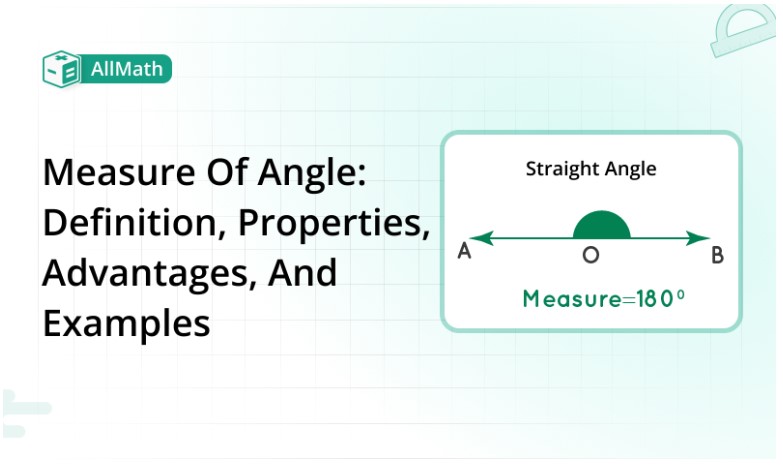To calculate result you have to disable your ad blocker first.
Measure of Angle: Definition, Properties, Advantages, and Examples

Publish Date: 08 Aug, 2023
Table of Content
- 01. Angle Measurement in Geometry
- 02. Tools for the Measurement of an Angle
- 03. The Role of Angle Measurement
- 04. Properties of Angle Measurement
- 05. Applications of Angle Measurement in Geometry
- 06. Benefits of Angle Measurement
- 07. Challenges and Considerations
- 08. Future Implications and Developments
- 09. Wrap up
Mathematical geometry is important because it provides a structure for studying and understanding the characteristics of forms and figures. Mathematicians can more fully measure and evaluate geometric characteristics because of the new technique offered by angle measurement.
It adds a new dimension to geometric analysis, providing fresh insights and expanding our understanding of geometric structures.
Angle Measurement in Geometry
The angle measurement concept, also called the Angelic measure, is a quantitative assessment of geometric qualities using numerical measurements. It has been shaped by Angelic symbols, connecting angels to beautiful wisdom and understanding.
Tools for the Measurement of an Angle
For the most particular, we used three instruments to measure angles. These are listed below:
- Protractors
- Squares
- Compass
Protector
A protractor is used to measure angles in degrees (°). With the use of a protractor, one can measure and compute angles in terms of degrees.
Follow these steps to use a protractor to measure the angle:
- Place the protractor's middle point or midway on the angle's vertex.
- One angle side should be placed on the protractor's zero-marked line (where you see the number 0).
- Locate the degree measure at which the angle on the other side of the protractor is pointed.
Square
Meter squares are used for 45° angles, whereas a square identifies and references a 90° angle.
For the measurement of an angle using a square, follow these steps:
- Set the square in place.
- Adjust the opposite arm.
- Observe the measurement.
- Keep the measurement on record.
Compass
Compasses are used to draw angles in different ways.
Using a compass, use the following steps to measure an angle:
- Keep the compass set.
- Adjust the compass.
- Sketch arcs.
- Measure the angle.
- Use a ruler to measure the angle.
The Role of Angle Measurement
Angle Measurement plays a significant role in geometric analysis by allowing mathematicians to measure, compare, and analyze various geometric properties. It provides a systematic approach to understanding geometric figure relationships and characteristics.
Properties of Angle Measurement
Angle Measurement allows mathematicians to quantify a wide range of geometric properties, which are as follows:
- Angles
- Lengths
- Areas
- Volumes
Angles
Angle Measurement provides a means to assign numerical measures to Angles, easy comparisons, and analysis of their sizes and relationships.
Lengths
Using Angle Measurement, mathematicians can measure and compare the lengths of line segments and other geometric elements, helping analyze proportions and ratios.
Areas
Angle Measurement allows the quantification of the areas of polygons, circles, and other geometric shapes, allowing for accurate comparisons and analysis.
Volumes
In three-dimensional geometry, Angle Measurement extends to the measurement of volumes of solids, providing awareness of dimensional relationships and comparisons.
Applications of Angle Measurement in Geometry
Angle Measurement has applications in various areas of geometry, including:
- Euclidean Geometry
- Trigonometry
- Geometric Transformations
Euclidean Geometry
By giving geometric qualities quantitative measurements, Angle measurement improves the study of Euclidean geometry by allowing mathematicians to analyze triangles, polygons, and other forms.
Trigonometry
Trigonometry depends significantly on Angle measurement, which enables mathematicians to determine trigonometric ratios as well as measure and compare angles, triangle lengths, and areas.
Geometric Transformations
Angle Measurement assists in understanding and quantifying geometric transformations, such as translations, rotations, reflections, and expansion.
Benefits of Angle Measurement
Some key benefits of angle measurement are as follows:
- Quantitative Comparisons
- Enhanced Precision
- New Perspectives
Quantitative Comparisons
Angle Measurement enables mathematicians to make quantitative comparisons between geometric properties, facilitating the identification of similarities, differences, and relationships.
Enhanced Precision
By assigning numerical measures, Angle Measurement provides a level of precision that aids in rigorous geometric analysis. It allows mathematicians to identify subtle variations and patterns.
New Perspectives
Angle Measurement offers a fresh perspective in geometric analysis and reveals previously unseen connections and properties. It inspires creative thinking and encourages mathematicians to explore new paths.
Challenges and Considerations
Some challenges in Angle measurement are as follows:
- Subjectivity
- Complexity
Subjectivity
Assigning measures to geometric properties may involve some subjectivity, as different mathematicians may interpret and quantify properties differently. Clear definitions and standards are compulsory to minimize subjectivity.
Complexity
Angle Measurement can become more complex when dealing with complex geometric structures. Developing advanced measurement techniques and algorithms is crucial to handling complex geometric phenomena.
Future Implications and Developments
The concept of Angle Measurement continues to evolve, opening doors to new discoveries and advancements in geometry. Following are a few possible impacts:
- Advanced Measurement Techniques
- Integration with Technology
Advanced Measurement Techniques
As geometric analysis progresses, more pure and advanced measurement techniques will be developed, allowing for more precise and comprehensive assessments.
Integration with Technology
The integration of Angle Measurement with technology, such as computer-assisted geometric analysis, can lead to automated measurement tools and enhanced visualization capabilities.
Wrap up
Angle Measurement brings a fresh perspective to geometric analysis, allowing mathematicians to accurately quantify and assess geometric properties. It plays a significant role in understanding the relationships and characteristics of geometric figures.

